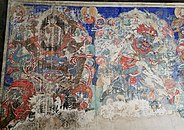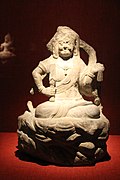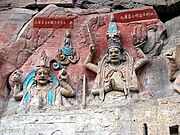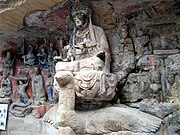Wisdom King
| Part of a series on |
| Vajrayana Buddhism |
|---|
 |
A Wisdom King (Sanskrit: विद्याराज; IAST: Vidyārāja, Chinese: 明王; pinyin: Míngwáng; Japanese pronunciation: Myōō) is a type of wrathful deity in East Asian Buddhism.
Whereas the Sanskrit name is translated literally as "wisdom / knowledge king(s)," the term vidyā in Vajrayana Buddhism is also specifically used to denote mantras;[1] the term may thus also be rendered "mantra king(s)."[2][3] Vidyā is translated in Chinese with the character 明 (lit. "bright, radiant", figuratively "knowledge(able), wisdom, wise"), leading to a wide array of alternative translations such as "bright king(s)" or "radiant king(s)". A similar category of fierce deities known as Herukas are found in Tibetan Buddhism.
The female counterparts of Wisdom Kings are known as Wisdom Queens (Sanskrit (IAST): Vidyārājñī, Chinese: 明妃, Míngfēi, Japanese: Myōhi).
Overview[edit]
Development[edit]

Vidyārājas, as their name suggests, are originally conceived of as the guardians and personifications of esoteric wisdom (vidyā), namely mantras and dharanis. They were seen as embodying the mystic power contained in these sacred utterances.[2][4]
During the early stages of esoteric (Vajrayana) Buddhism, many of the deities that would become known as vidyārājas (a term that only came into use around the late 7th-early 8th century[5]) were mainly seen as attendants of bodhisattvas who were invoked for specific ends such as the removal of misfortune and obstacles to enlightenment. They personified certain attributes of these bodhisattvas such as their wisdom or the power of their voices and were held to perform various tasks such as gathering together sentient beings to whom the bodhisattva preaches, subjugating unruly elements, or protecting adherents of Buddhism.[6] Eventually, these divinities became objects of veneration in their own right; no longer necessarily paired with a bodhisattva, they became considered as the manifestations of the bodhisattvas themselves and/or of buddhas, who are believed to assume terrifying forms as a means to save sentient beings out of compassion for them.[7] A belief prevalent in the Japanese tradition known as the sanrinjin (三輪身, "bodies of the three wheels") theory for instance posits that five Wisdom Kings are the fierce incarnations (教令輪身, kyōryōrin-shin, lit. "embodiments of the wheel of injunction") of the Five Wisdom Buddhas, who appear both as gentle bodhisattvas who teach the Dharma through compassion and as terrifying vidyārājas who teach through fear, shocking nonbelievers into faith.[8][9][10][11]
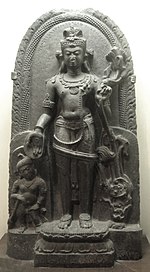
The evolution of the vidyārāja will be illustrated here by the deity Yamāntaka, one of the earliest Buddhist wrathful deities. In the 6th century text Mañjuśrī-mūla-kalpa, Yamāntaka is portrayed as the oath-bound servant of the bodhisattva Mañjuśrī who assembles all beings from across the world to hear the Buddha's preaching and vanquishes (and converts) those who are hostile to Buddhism; at the same time, Yamāntaka is also the personification of Mañjuśrī's dharani, the benefits of which are identical to his abilities.[12] He was also commonly depicted in statuary along with Mañjuśrī as a diminutive yaksha-like attendant figure.[13]

Later, as Yamāntaka and similar subordinates of various bodhisattvas (e.g. Hayagrīva, who was associated with Avalokiteśvara) became fully independent deities, they began to be portrayed by themselves and increasingly acquired iconographic attributes specific to each. Yamāntaka for instance is commonly shown with six heads, arms, and legs and riding or standing on a buffalo mount.[14] The status and function of these deities have shifted from being minor emissaries who gather together and intimidate recalcitrant beings to being intimately involved in the primary task of esoteric Buddhism: the transformation of passions and ignorance (avidyā) into compassion and wisdom.[15] As a result of this development, the relationship between Mañjuśrī and Yamāntaka was recontextualized such that Yamāntaka is now considered to be the incarnation of Mañjuśrī himself (so the Mañjuśrī-nāma-samgīti).[14] Eventually, in the sanrinjin interpretation of Japanese esoteric Buddhism, both Yamāntaka and Mañjuśrī - under the name 'Vajratīkṣṇa' (Japanese: 金剛利菩薩, Kongōri Bosatsu)[16][17] - became classified as avatars of the buddha Amitābha.[18][19]
Other Wisdom Kings followed a more or less similar development. Hayagrīva, for example, was originally the horse-headed incarnation of the Hindu god Vishnu which was adopted into Buddhism as Avalokiteśvara's attendant (although unlike the Hindu Hayagrīva, the Buddhist figure was never portrayed with a horse's head, instead being depicted like Yamāntaka as a yaksha who may have a miniature horse head emerging from his hair).[20] Eventually, as Hayagrīva increasingly rose to prominence, the distinction between him and his superior became increasingly blurred so that he ultimately turned into one of Avalokiteśvara's many guises in both China and Japan.[21] One of the more famous vidyārājas, Acala (Acalanātha), was originally an acolyte or messenger of the buddha Vairocana before he was interpreted as Vairocana's fierce aspect or kyōryōrin-shin in the Japanese tradition.[22] (In Nepal and Tibet, meanwhile, he is instead identified as the incarnation of either Mañjuśrī or the buddha Akṣobhya.[23][24][25][26])
Iconography[edit]
The iconography of Buddhist wrathful deities are usually considered to be derived from both yaksha imagery and Shaivite iconography, specifically from the wrathful forms of the Hindu god Shiva (e.g. Bhairava).[27][28]
Wisdom Kings are usually represented as fierce-looking, often with blue or black skin and multiple heads, arms, and legs. They hold various weapons in their hands and are sometimes adorned with skulls, snakes or animal skins and wreathed in flames. This fiery aura is symbolically interpreted as the fire that purifies the practitioner and transforms one's passions into awakening, the so-called "fire samadhi" (火生三昧, Japanese: kashō-zanmai).[29]
Certain vidyārājas bear attributes that reflect the historical rivalry between Hinduism and Buddhism. For instance, the Wisdom King Trailokyavijaya is shown defeating and trampling on the deva Maheśvara (one of the Buddhist analogues to Shiva) and his consort Umā (Pārvatī).[30] A commentary on the Mahavairocana Tantra by the Tang monk Yi Xing meanwhile attributes the taming of Maheśvara to another vidyārāja, Acala.[31] Acala himself is sometimes shown trampling on an elephant-headed demon/deity who may share a common origin with the Hindu Ganesha named Vighnarāja (the "Lord of Obstacles") in Tibetan art.[32]
List of Wisdom Kings[edit]
The Five Wisdom Kings[edit]
In Chinese and Japanese (Shingon and Tendai) esoteric Buddhism, the Five Great Wisdom Kings (五大明王, Jp. Godai Myōō; Ch. Wǔ Dà Míngwáng), also known as the Five Guardian Kings, are a group of vidyārājas who are considered to be both the fierce emanations of the Five Wisdom Buddhas and the guardians of Buddhist doctrine.[33][34] Organized according to the five directions (the four cardinal points plus the center), the Five Kings are usually defined as follows:
- Acala / Acalanātha (不動明王; Jp. Fudō Myōō; Ch. 不動明王, Bùdòng Míngwáng) - Manifestation of Mahāvairocana, associated with the center
- Trailokyavijaya (降三世明王; Jp. Gōzanze Myōō; Ch. Xiángsānshì Míngwáng) - Manifestation of Akṣobhya, associated with the east
- Kuṇḍali / Amṛtakuṇḍalin (軍荼利明王, Jp. Gundari Myōō; Ch. Jūntúlì Míngwáng) - Manifestation of Ratnasambhava, associated with the south
- Yamāntaka (大威徳明王; Jp. Daiitoku Myōō; Ch. Dàwēidé Míngwáng) - Manifestation of Amitābha, associated with the west
- Vajrayakṣa (金剛夜叉明王, Jp. Kongōyasha Myōō; Ch. Jīngāng Yèchā Míngwáng) - Manifestation of Amoghasiddhi, associated with the north in the Shingon school
| Vajrayakṣa or Ucchuṣma
(north) |
||
| Yamāntaka
(west) |
Acala
(center) |
Trailokyavijaya
(east) |
| Kuṇḍali
(south) |

The Eight Wisdom Kings[edit]
In Chinese Buddhism, the Eight Great Wisdom Kings (八大明王; pinyin: Bā Dà Míngwáng), is another grouping of Wisdom Kings that is depicted in statues, mural art and paintings. The acknowledged canonical source of the grouping of eight is the Mañjuśrī-mūla-kalpa, the Chinese translation of which (大方廣菩薩藏文殊舍利根本儀軌經; Dà fāngguǎng Púsà Zàng Wénshūshèlì Gēnběn Yíguǐ Jīng, lit. "The Fundamental Ordinance of Mañjuśrī") in about 980-1000 CE is attributed to the monk Tianxizai, who is possibly the north Indian Shantideva.[36] Each of the Wisdom Kings correspond to one of the Eight Great Bodhisattvaszh] in Chinese Buddhism as well as to a specific compass direction.
The Eight Wisdom Kings, with exceptions in certain lists, are usually defined as:[36]
- Acala - Manifestation of the bodhisattva Sarvanivāraṇaviṣkambhin, associated with the north-east
- Kuṇḍali - Manifestation of the bodhisattva Ākāśagarbha, associated with the north-west
- Trailokyavijaya - Manifestation of the bodhisattva Vajrapāṇi, associated with the south-east
- Mahācakra (大輪明王; Ch. Dàlún Míngwáng) - Manifestation of the bodhisattva Maitreya, associated with the south-west
- Padanakṣipa (步擲明王; Ch. Bùzhì Míngwáng) - Manifestation of the bodhisattva Samantabhadra, associated with the north
- Aparājita (無能勝明王; Ch. Wúnéngshēng Míngwáng) - Manifestation of the bodhisattva Kṣitigarbha, associated with the south
- Yamāntaka - Manifestation of the bodhisattva Mañjuśrī, associated with the east
- Hayagrīva (馬頭觀音; Ch. Mǎtóu Guānyīn) - Manifestation of the bodhisattva Avalokiteśvara (Guanyin), associated with the west
| Kuṇḍali
(north-west) |
Padanakṣipa
(north) |
Acala
(north-east) |
| Hayagrīva
(west) |
Yamāntaka
(east) | |
| Mahācakra
(south-west) |
Aparājita
(south) |
Trailokyavijaya
(south-east) |
The Ten Wisdom Kings[edit]

Another grouping found in certain Chinese depictions is the Ten Great Wisdom Kings (十大明王; Shí Dà Míngwáng). The acknowledged canonical source of the grouping is from The Sutra of the Liturgy for Brilliant Contemplation of the Ten Wrathful Wisdom Kings of the Illusory Net of the Great Yoga Teachings (佛說幻化網大瑜伽教十忿怒明王大明觀想儀軌經; Fóshuō Huànhuàwǎng Dà yújiājiào Shífènnù Míngwáng Dàmíng Guānxiǎng Yíguǐ Jīng).[36] There are several different groupings of the ten Kings, which differ in the removal and addition of certain vidyārājas, as well as attributing some Kings to different buddhas and bodhisattvas. In medieval and modern Chinese Buddhist practice, the Ten Kings are regularly invoked in repentance ceremonies, such as the Liberation Rite of Water and Land, where they are offered offerings and entreated to expel evil from the ritual platform.[37][38]
One version of the list of Ten Wisdom Kings are as follows:[36]
- Acala - Manifestation of Sarvanivāraṇaviṣkambhin
- Trailokyavijaya - Manifestation of Vajrapani
- Mahācakra - Manifestation of Maitreya
- Padanakṣipa - Manifestation of Samantabhadra
- Aparājita - Manifestation of Kṣitigarbha
- Yamāntaka - Manifestation of Amitābha
- Hayagrīva - Manifestation of Avalokiteśvara
- Vajrahāsa (大笑明王; Ch. Dàxiào Míngwáng) - Manifestation of Ākāśagarbha
- Ucchuṣma (穢跡金剛明王; Ch. Huìjì Jīngāng Míngwáng, lit. "Vajra Being of Impure Traces") - Manifestation of Śakyamuni
- Ucchuṣma (?) (火頭金剛明王; Ch. Huǒtóu Jīngāng Míngwáng, lit. "Fire-Headed Vajra Being") - Manifestation of Mahāvairocana[a]
Another version of the list identifies the ten Kings with different buddhas and bodhisattvas:
- Acala - Sarvanivāraṇaviṣkambhin
- Kuṇḍali - Amitābha
- Trailokyavijaya - Vajrapāṇi
- Mahācakra - Maitreya
- Padanakṣipa - Samantabhadra
- Aparājita - Kṣitigarbha
- Yamāntaka - Mañjuśrī
- Hayagrīva - Avalokiteśvara
- Vajrahāsa - Ākāśagarbha
- Mahābala (大力明王; Ch, Dàlì Míngwáng) - Śakyamuni
- Ming dynasty mural of the Ten Wisdom Kings in Dayun Temple in Hunyuan, Datong, Shanxi, China
-
Mahābala (大力明王; Dàlì Míngwáng)
-
Aparajita (Wúnéngshēng Míngwáng) on the left and Padanaksipa (Bùzhì Míngwáng) on the right
-
Trailokyavijaya (Xiángsānshì Míngwáng)
Others[edit]

Other deities to whom the title vidyārāja is applied include:
- Rāgarāja (愛染明王; Ch. Àirǎn Míngwáng; Jp. Aizen Myōō) - A vidyaraja considered to transform worldly lust and sexual passion into spiritual awakening; manifestation of the bodhisattva Vajrasattva and/or the buddha Vairochana.[39]
- Āṭavaka (大元帥明王; Ch. Dàyuánshuài Míngwáng; Jp. Daigensui Myōō or 大元明王, Daigen Myōō) - A yaksha attendant of the deva Vaishravana.
- Mahāmāyūrī (孔雀明王; Ch. Kǒngquè Míngwáng; Jp. Kujaku Myōō) - A Wisdom Queen (vidyārājñī); sometimes also classified as a bodhisattva. Unlike most other vidyārājas, s/he is depicted with a benevolent expression.
- Mahākrodharāja (大可畏明王; Ch. Dàkěwèi Míngwáng; Jp. Daikai Myōō) - Attendant or manifestation of Amoghapasha (不空羂索観音; Ch. Bùkōng Juànsuǒ Guānyīn; Jp. Fukū Kensaku/Kenjaku Kannon), one of Avalokiteshvara's forms.[40][41][42]
- Sadākṣara (六字明王; Ch. Liùzì Míngwáng; Jp. Rokuji Myōō) - A deification of the Sadākṣara (Six-Letter) Sutra Ritual (六字経法; Jp. Rokuji-kyō hō), a rite of subjugation focused on the six manifestations of Avalokiteshvara.[43] Unlike other Wisdom Kings but like Mahamayuri, he sports a gentle bodhisattva-like countenance and is shown with four or six arms and standing on one leg.[44][45][46]
Examples[edit]
Examples of depictions of the Eight Wisdom Kings can be found at:
- Cliff reliefs and rock carvings at Shizhongshan Grottoes[zh] in Jianchuan, Yunnan
- Statues in the Datong Guanyin Hall[zh] in Datong, Shanxi
- Frescos in the pagoda at Jueshan Temple[zh] in Lingqiu, Shanxi
Examples of depictions of the Ten Wisdom Kings can be found at:
- Rock carvings at the Dazu Rock Carving sites in Dazu, Chongqing
- Statues in Shuanglin Temple near Pingyao, Shanxi
- Statues in Shuilu Nunnery[zh] in Lantian, Xi'an
- Frescos in Qinglong Temple in Jishan, Shanxi
- Frescos in Yong'an Temple[zh] in Hunyuan, Shanxi
- Frescos in Yunlin Temple[zh] in Yanggao, Shanxi
- Frescos in Pilu Temple[zh] in Shijiazhuang, Hebei
- Frescos in Dayun Temple[zh] in Hunyuan, Shanxi
- Water and Land Ritual paintings from various temples, such as Baoning Temple[zh] in Youyu, Shanxi (Currently kept in the Shanxi Museum)
- Documents and carvings from the Mogao Caves near Dunhuang, Gansu
Gallery[edit]
-
Tang dynasty statue of Acala, now kept at the Forest of Steles, Beilin Stone Museum in Xi'an, Shaanxi Province, China
-
Head of a Qing dynasty statue of Hayagrīva, now held in the Gansu Provincial Museum, Lanzhou, Gansu, China
-
Trailokyavijaya in the Buddhist relic collection at the Buddha Tooth Relic Temple and Museum (Chinatown, Singapore)
-
Hayagrīva (left) and Trailokyavijaya (right), part of the Dazu Rock Carvings
-
Statue of Āṭavaka at Akishino-dera, Nara, Japan
-
The Wisdom Queen Mahāmāyūrī surrounded by various devas, part of the Dazu Rock Carvings
See also[edit]
- Dharmapāla and Lokapāla, guardian deities
- Zaō Gongen
Notes[edit]
- ^ Huìjì Jīngāng and Huǒtóu Jīngāng are sometimes considered to be different names for the same figure, but at times are also regarded as two separate deities.
References[edit]
- ^ Toganoo, Shozui Makoto (1971). "The Symbol-System of Shingon Buddhism (1)". Journal of Esoteric Buddhism – Mikkyō Bunka: 91, 86.
- ^ a b Haneda (2018), pp. 25–27.
- ^ Mack (2006), p. 298.
- ^ Faure (2015a), p. 116.
- ^ Linrothe (1999), p. 90.
- ^ Linrothe (1999), p. 13, 64-65.
- ^ Linrothe (1999), p. 13.
- ^ Baroni (2002), p. 100.
- ^ Miyasaka (2006), p. 56.
- ^ 昭和新纂国訳大蔵経 解説部第1巻 (Shōwa shinsan Kokuyaku Daizōkyō: Kaisetsu, vol. 1) (in Japanese). Tōhō Shuppan. 1930. p. 120.
- ^ "三輪身". コトバンク (kotobank) (in Japanese). Retrieved 2020-11-28.
- ^ Linrothe (1999), p. 64-67.
- ^ Linrothe (1999), pp. 68–81.
- ^ a b Linrothe (1999), pp. 163–175.
- ^ Linrothe (1999), pp. 155.
- ^ "3. 両界曼荼羅(りょうかいまんだら)". Shingon-shū Sennyū-ji-ha Jōdo-ji Official Website. Retrieved 2021-09-28.
- ^ "Vajratiksna". English Tibetan Dictionary Online. Retrieved 2021-09-28.
- ^ "大威徳明王". コトバンク (Kotobank). Retrieved 2021-09-28.
- ^ "大威徳明王". Shingon-shū Buzan-ha Kōki-zan Jōfuku-ji Official Website. Retrieved 2021-09-28.
- ^ Linrothe (1999), pp. 85–91.
- ^ Chandra (1988), pp. 29–31.
- ^ Faure (2015a), pp. 120–123.
- ^ Pal (1974), p. 6.
- ^ "Acala, The Buddhist Protector". Metropolitan Museum of Art. Retrieved 2020-11-28.
- ^ Jha (1993), pp. 35–36.
- ^ "Sacred Visions: Early Paintings from Central Tibet - Achala". www.asianart.com. Retrieved 2020-11-28.
- ^ Linrothe (1999), p. 330.
- ^ Van Hartingsveldt, Michael (2018-09-21). "With the Wrath of a Serpent: The Propagation of Gundari Myо̄о̄ Iconography". Buddhistdoor Global. Retrieved 2021-09-25.
- ^ Faure (2015a), p. 117.
- ^ Linrothe (1999), pp. 178–187.
- ^ Faure (2015a), pp. 124–125.
- ^ Faure (2015b), pp. 47, 94–98.
- ^ De Visser (1928), pp. 143–151.
- ^ Vilbar, Sinéad (October 2013). "Kings of Brightness in Japanese Esoteric Buddhist Art". The Metropolitan Museum of Art. Retrieved 2021-10-01.
- ^ "五大尊". Flying Deity Tobifudō (Ryukō-zan Shōbō-in Official Website). Retrieved 2021-10-01.
- ^ a b c d Howard (2002), pp. 92–107.
- ^ Bloom, Phillip Emmanual (2013). Descent of the Deities: The Water-Land Retreat and the Transformation of the Visual Culture of Song-Dynasty (960–1279) Buddhism (Thesis). OCLC 864907811. ProQuest 1422026705.[page needed]
- ^ Hong, Tsai-Hsia (2005). The Water-Land Dharma Function Platform Ritual and the Great Compassion Repentance Ritual. OCLC 64281400.[page needed]
- ^ "愛染明王". Flying Deity Tobifudo (Ryūkō-zan Shōbō-in Official Website). Retrieved 2021-10-16.
- ^ Linrothe (1999), p. 89.
- ^ "仏像がわかる! バックナンバー4・明王部". Kōya-san Shingon-shū Hōon-in Official Website. Retrieved 2021-10-02.
- ^ "不空大可畏明王央俱拾真言" (PDF). JBox-智慧宝箧. Retrieved 2021-10-02.
- ^ Fuji, Tatsuhiko (2012). 呪法全書 (Juhō Zensho). Gakken Plus. ISBN 978-4-0591-1008-8.
- ^ "円成庵 木造六字尊立像". 2017年度 文化財維持・修復事業助成 助成対象. The Sumitomo Foundation. Retrieved 2021-10-16.
- ^ "木造六字明王立像". Takamatsu City Official Website. Retrieved 2021-10-16.
- ^ "六字明王". Flying Deity Tobifudo (Ryūkō-zan Shōbō-in Official Website). Retrieved 2021-10-16.
Further reading[edit]
- Baroni, Helen Josephine (2002). The Illustrated Encyclopedia of Zen Buddhism. New York: Rosen Pub. Group. ISBN 0-8239-2240-5.
- Chandra, Lokesh (1988). The Thousand-Armed Avalokiteśvara, Volume 1. Abhinav Publications. ISBN 978-8-1701-7247-5.
- De Visser, Marinus Willem (1928). Ancient Buddhism in Japan. Brill Archive.
- Faure, Bernard (2015a). The Fluid Pantheon: Gods of Medieval Japan, Volume 1. University of Hawaii Press. ISBN 978-0-8248-5702-8.
- Faure, Bernard (2015b). Protectors and Predators: Gods of Medieval Japan, Volume 2. University of Hawaii Press. ISBN 978-0-8248-5772-1.
- Haneda, Shukai (2018). 不動明王から力をもらえる本 (Fudō Myōō kara chikara o moraeru hon) (in Japanese). Daihōrinkaku. ISBN 978-4-8046-1386-4.
- Howard, Angela F. (1999-03-01). "The Eight Brilliant Kings of Wisdom of Southwest China". Res: Anthropology and Aesthetics. 35: 92–107. doi:10.1086/RESv35n1ms20167019. ISSN 0277-1322. S2CID 164236937. Archived from the original on 2021-08-24. Retrieved 2021-08-24.
- Jha, Achyutanand (1993). Tathagata Akshobhya and the Vajra Kula: Studies in the Iconography of the Akshobhya Family. National Centre for Oriental Studies.
- Linrothe, Robert N. (1999). Ruthless Compassion: Wrathful Deities in Early Indo-Tibetan Esoteric Buddhist Art. Serindia Publications, Inc. ISBN 978-0-9060-2651-9.
- Mack, Karen (2006). "The Phenomenon of Invoking Fudō for Pure Land Rebirth in Image and Text". Japanese Journal of Religious Studies. 33 (2): 297–317. JSTOR 30234078.
- Miyasaka, Yūshō (2006). 不動信仰事典 (Fudō-shinkō Jiten) (in Japanese). Ebisu Kōshō Shuppan. ISBN 978-4-900901-68-1.
- Pal, Pratapaditya (1974). The Arts of Nepal - Volume II: Painting. Brill Archive. ISBN 978-90-04-05750-0.







